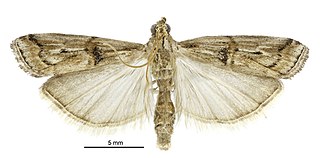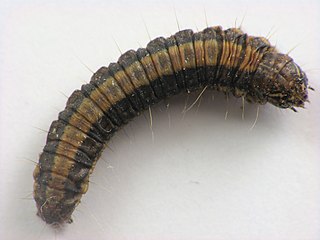
Crambidae comprises the grass moth family of lepidopterans. They are variable in appearance, with the nominal subfamily Crambinae taking up closely folded postures on grass stems where they are inconspicuous, while other subfamilies include brightly coloured and patterned insects that rest in wing-spread attitudes.

The Pyralidae, commonly called pyralid moths, snout moths or grass moths, are a family of Lepidoptera in the ditrysian superfamily Pyraloidea. In many classifications, the grass moths (Crambidae) are included in the Pyralidae as a subfamily, making the combined group one of the largest families in the Lepidoptera. The latest review by Eugene G. Munroe and Maria Alma Solis retain the Crambidae as a full family of Pyraloidea.

The Pyraloidea are a moth superfamily containing about 16,000 described species worldwide, and probably at least as many more remain to be described. They are generally fairly small moths, and as such, they have been traditionally associated with the paraphyletic Microlepidoptera.

Spilomelinae is a very species-rich subfamily of the lepidopteran family Crambidae, the crambid snout moths. With 4,135 described species in 344 genera worldwide, it is the most speciose group among pyraloids.

The Pyralinae are the typical subfamily of snout moths and occur essentially worldwide, in some cases aided by involuntary introduction by humans. They are rather rare in the Americas however, and their diversity in the Australian region is also limited. Altogether, this subfamily includes about 900 described species, but new ones continue to be discovered. Like many of their relatives in the superfamily Pyraloidea, the caterpillar larvae of many Pyralinae – and in some cases even the adults – have evolved the ability to use unusual foods for nutrition; a few of these can become harmful to humans as pests of stored goods.

Argyractis is a genus of moths of the family Crambidae.
Caffrocrambus is a genus of moths of the family Crambidae.

Placosaris is a genus of snout moths in the subfamily Pyraustinae of the family Crambidae. It is placed in the tribe Pyraustini.

Pyralis manihotalis is a moth of the family Pyralidae described by Achille Guenée in 1854.

Hypsopygia mauritialis is a moth of the family Pyralidae described by Jean Baptiste Boisduval in 1833. It is a widespread species, known from Africa, India, China, Malaysia, Taiwan, Japan, Australia and Hawaii.

Pempelia genistella, the gorse colonial hard shoot moth, is a moth of the family Pyralidae. It is native to south-western Europe and north-western Africa, but has been introduced as a biological control agent for gorse in New Zealand and Hawaii.

Dioryctria simplicella is a moth of the family Pyralidae. It is known from Europe, except the southern parts.

Aphomia terrenella, the terrenella bee moth, is a moth of the family Pyralidae. It is found in North America from Michigan, Ontario, Quebec and New York south to Georgia.

The Phycitinae are a subfamily of snout moths. Even though the Pyralidae subfamilies are all quite diverse, Phycitinae stand out even by standards of their family: with over 600 genera considered valid and more than 4000 species placed here at present, they unite up more than three-quarters of living snout moth diversity. Together with the closely related Epipaschiinae, they are apparently the most advanced lineage of snout moths.

The Galleriinae are a subfamily of snout moths and occur essentially worldwide, in some cases aided by involuntary introduction by humans. This subfamily includes the wax moths, whose caterpillars (waxworms) are bred on a commercial scale as food for pets and as fishing bait; in the wild, these and other species of Galleriinae may also be harmful to humans as pests.

The Epipaschiinae are a subfamily of snout moths. More than 720 species are known today, which are found mainly in the tropics and subtropics. Some occur in temperate regions, but the subfamily is apparently completely absent from Europe, at least as native species. A few Epipaschiinae are crop pests that may occasionally become economically significant.

Amyelois is a monotypic snout moth genus described by Hans Georg Amsel in 1956. Its single species, Amyelois transitella, the navel orangeworm, described by Francis Walker in 1863, is endemic to the tropical Western Hemisphere, including the southern United States. Its abundance in California increased greatly during the first half of the 20th century.
Thiallela epicrociella is a species of moth of the family Pyralidae described by Embrik Strand in 1919. It is found in Taiwan.
Salma validalis is a species of moth of the family Pyralidae. It is found in India, Sri Lanka, Borneo and Taiwan.
Thylacoptila paurosema is a species of moth of the family Pyralidae. It has a wide range and is found on the Canary Islands, Cabo Verde, Ethiopia, Ghana, Réunion, Saudi Arabia, Sierra Leone, Sudan, Namibia, South Africa, Yemen, Madagascar, Indonesia, Burma, Malaysia, Pakistan, Sri Lanka, India and Ascension Island.
















